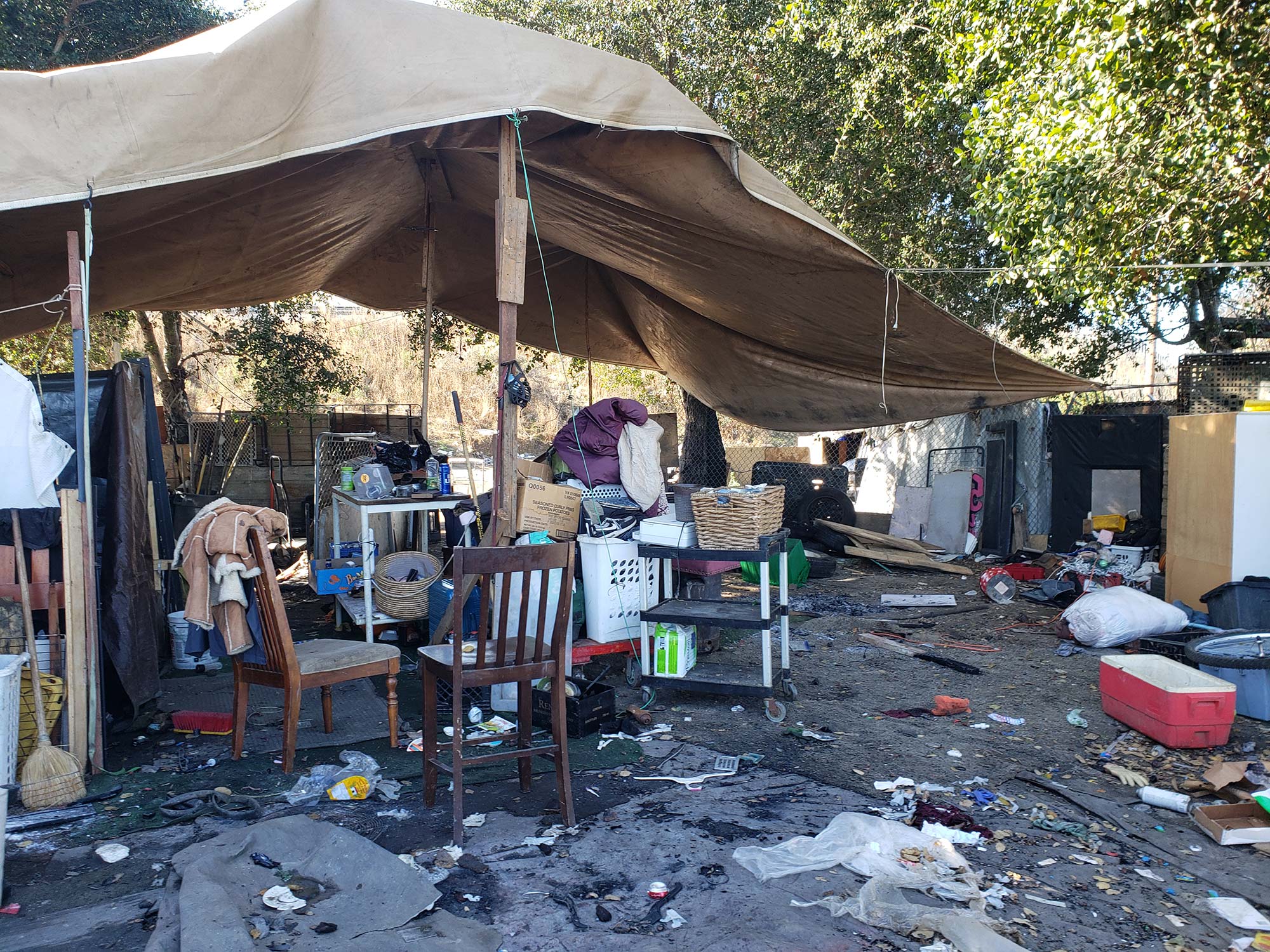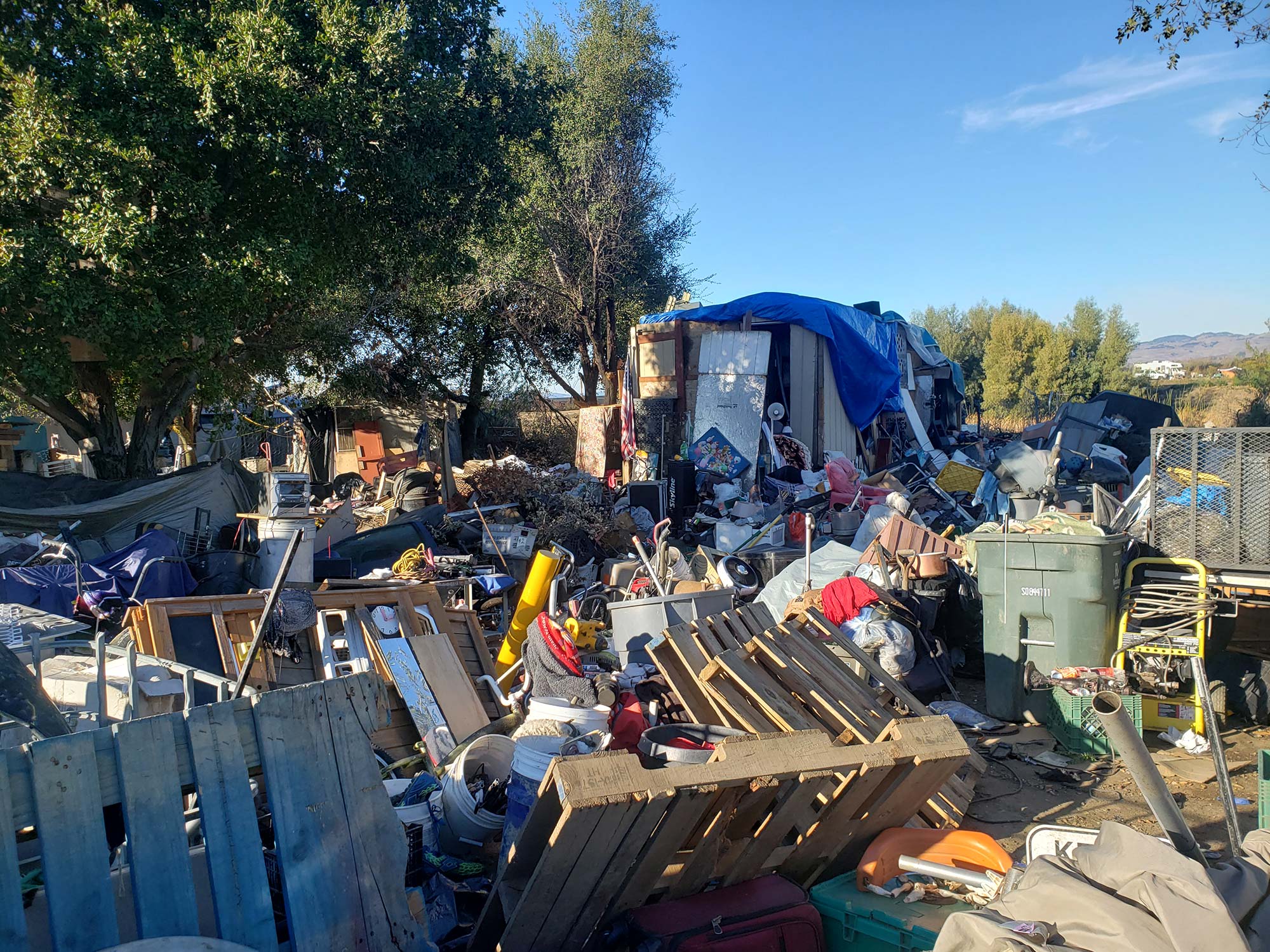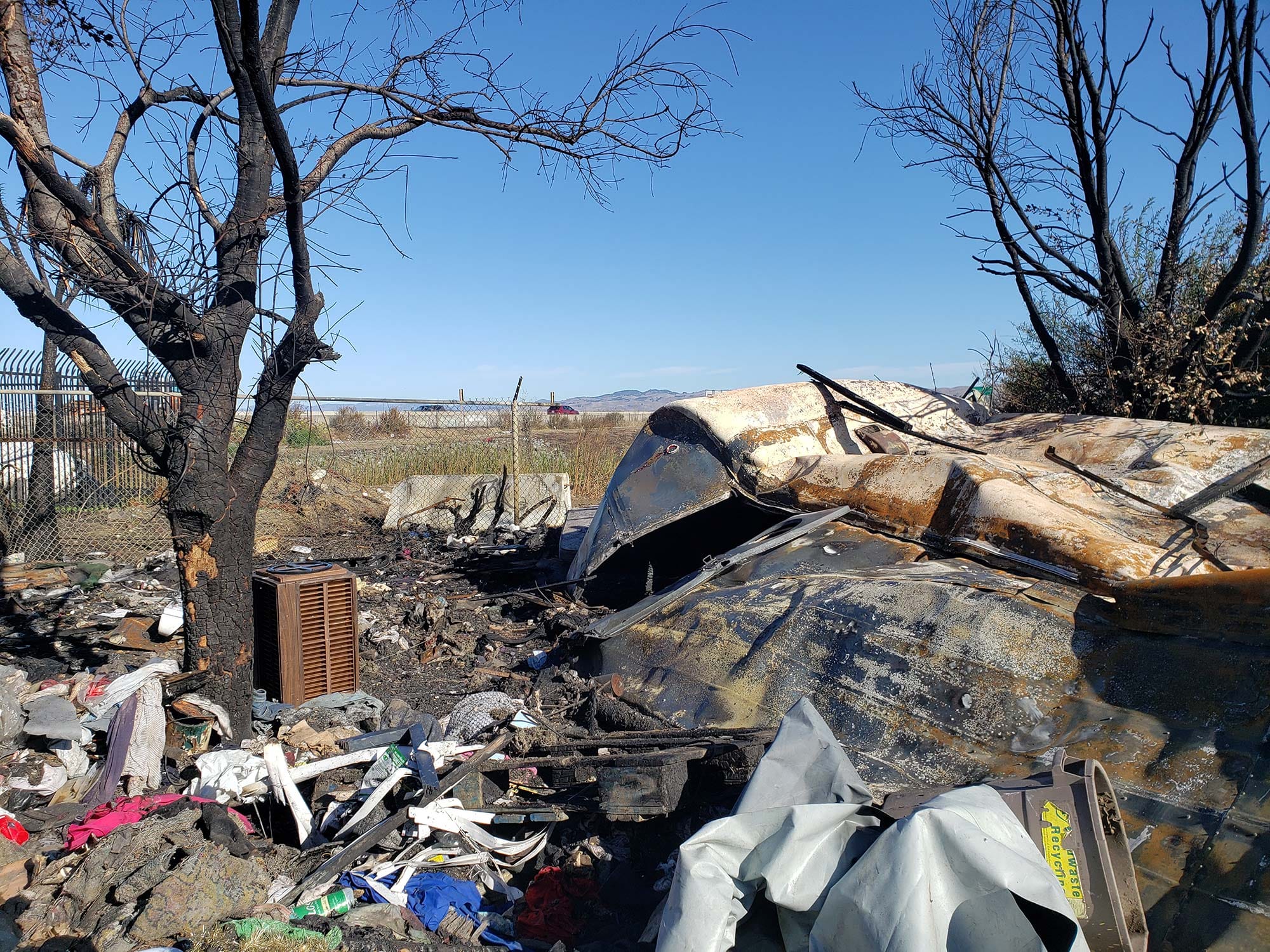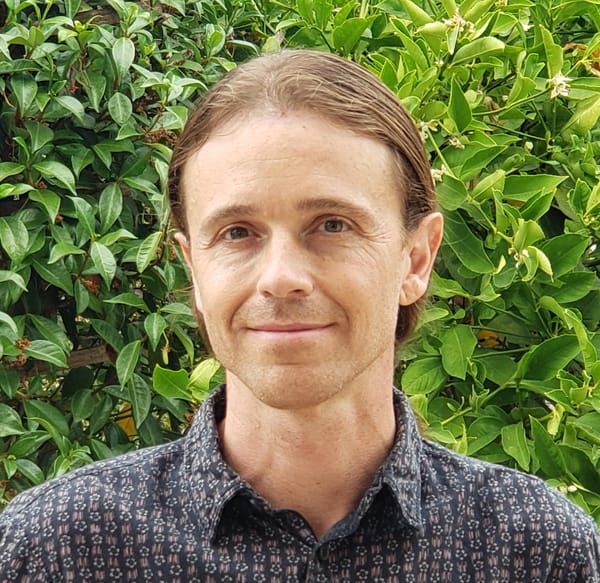VALLEJO – Caltrans, the city of Vallejo and other agencies are coordinating to remove as many as 50 people from one of the city’s largest and longest running encampments in the White Slough area in what is expected to be a week-long clean up effort.
Homeless residents of Vallejo have used the strip of land between Austin Creek and Sacramento Street alongside Highway 37 as a place to camp for at least six years. But neighborhood residents said that the camp became more firmly established after another large camp was removed from a private parcel of land on the other side of Highway 37 in 2020.
Caltrans officials posted notices on Nov. 8 stating that encampment residents must vacate the area by Nov. 17 in preparation for debris removal and clean up work that began on Monday.
Caltrans spokesperson Bart Ney said that the encampment is one of the largest that the agency has removed in his district, which includes the entire nine-county Bay Area. “It’s not quite as big as Wood Street in Oakland but it is on that scale,” he said.

Ney said the agencies are working to get the encampment cleared before an atmospheric river that is expected to hit the Bay Area by the end of the week makes the clean-up more difficult. Assistant to the City Manager Natalie Peterson said the city will not be opening the warming center for the storm because it does not meet the criteria set in the city’s policy.
On Saturday, a day before the final eviction date, several residents of the camp expressed frustration with the length of time that they were given to move and the lack of options for a place to go.
Peterson, who was coordinating the city of Vallejo’s role in the clean-up on Monday, said that the Solano County Hope Team and county contractor Abode Services visited the camp prior to the eviction date to update information for the county’s coordinated entry system or sign residents up for other programs provided through the county such as CalFresh benefits or Medicare services.
But many of the encampment residents said that county workers are not offering what they need most: permanent or temporary housing.
Andreas Schmidt, who lives in a nearby neighborhood, said that the camp has made the Bay Trail inaccessible because many people feel unsafe riding or walking the section that winds past the camp.
“I think that this place did become a community and I know that communities like to stick together but something has to happen, I mean where does this end?” Schmidt said, adding that he is part of the Vallejo Heights Neighborhood Association that has expressed concerns that frequent encampment fires could spread to nearby buildings.
Peterson said that the city has received numerous complaints about the encampment and that representatives from the state and federal level have reached out to the city to encourage the removal of the camp.
Outgoing Vallejo Mayor Robert McConnell was also a leading advocate for removing the encampment, according to Ney. McConnell lives in the neighborhood and has publicly expressed concerns about the concentration of encampments in the Sacramento Street area.
“The immediate priority is the clean-up,” said Peterson. “Then we will find ways for the community to reclaim the space and feel comfortable using the trail again.”
The Bay Conservation and Development Commission, which is charged with ensuring public access to the bay and preventing unpermitted bay fill and other environmental concerns, also had a role in the removal
Commission director of legislative and external affairs Ryland Gervase said that agency officials are concerned about the environmental impacts of the camp as well as the public’s access to the Bay Trail.
“Our concerns in the White Slough area are one, dumping of some of these very toxic chemicals into the area,” Gervase said. “We've seen a lot of reports about tires being dumped, car batteries and other items that leach toxic chemicals into the water. This is very harmful for a lot of our listed native fish species, particularly the juveniles that come into that area and use the slough as a kind of nursery.”
In 2021, members of the Sacramento Street camp successfully resisted an eviction in part due to the U.S. Ninth Circuit Court of Appeals ruling in Martin v. Boise that prohibited cities and counties from removing encampments without offering shelter. But the Supreme Court overturned the ruling in a review of a related Ninth Circuit decision, Grants Pass v. Johnson, finding that encampment removals do not violate Constitutional protections against cruel and unusual punishment.
Peterson said that the Supreme Court decision is one of the reasons that the removal of the encampment is now moving forward.
The stability of the long running location on Sacramento Street has allowed residents to build secure structures and create community networks that support the camp, said residents.
One resident established a bike shop, others built yards to keep pets or salvaged items to be deconstructed and sorted for recycling. There was also a tarp propped up with beams to create a large rain shelter that resembled a pavilion like communal living space.
Misty, who has been a resident of the encampment for over two years, said that with the recent increase in encampment removals, there are very few locations where a group can camp together. “I don’t want to go where somebody else is not around because messed up stuff can happen to women,” she said.
Misty works as a caregiver and she collects metal for recycling but she said that in the past social workers have told her that she does not qualify for housing support because of her income. She said that she could afford $800 or $1,000 for rent but it’s difficult for her to save up the $2,000 or more that it costs to get into a place.

Some neighboring businesses have also formed connections with the camp. Charles Ford, who runs an auto salvage yard and repair shop down the street from the camp, said that he and his wife have been working on creating a nonprofit to provide free vehicle repairs with parts from salvaged vehicles.
Ford said his yard often draws the ire of the California Highway Patrol’s Stolen Car task force and they have searched his yard four times and found nothing because he does not deal in stolen vehicles.
The camp has also sheltered a number of people with mental health and drug addiction issues. Some residents said that they have worked on their sobriety at the camp but others have struggled with a number of substances that are easily available.
Jennifer Llarinas, a resident at the encampment who was packing up her belongings on Monday, said that she has an obsessive compulsive disorder that makes it difficult for her to let go of things. “I just have to collect things and organize them even if they are not important like the things that hold memories of my kids,” she said.
Llarinas is a mother of three children who now live with their father. She said she lost her home because her landlord wanted to raise her rent more than the allowed increase. But because he couldn't force her out due to tenant protections, she feels that he found a way to evict her through the homeowners association.
Llarinas said that women at the camp are at risk of getting raped or worse if they do not have a close knit group of people who look after each other. She said that when she first arrived, she was assaulted and threatened but she eventually found a “family” to look out for her.
Llarinas said that she is well aware of why neighbors are complaining about the camp. She said there have been fires started by members of the camp for revenge or a dispute. But she said the trash and other items piled up at the camp are not all from the residents, because she regularly sees trucks come in to dump loads of garbage and junk.

Llarinas said that the social workers that came to the camp were not helpful but on her own she found someone who is helping her through the process of applying for housing.
Late on Monday morning, Misty had a boat trailer loaded up with lumber that she plans to reuse to build herself another home. She had parked nearby neighborhood street to rearrange the load run. She said that people were taking videos of her from their cars and one driver asked if she was trying to set up camp.
Another woman came out of a townhouse to tell her that she was concerned about whether her two chihuahuas had enough air inside her car. Misty said she pointed to the car’s hatchback, which is clearly damaged, leaving a wide air gap. “It’s exhausting how people treat you when you are homeless,” Misty said, shaking her head.
Before you go...
It’s expensive to produce the kind of high-quality journalism we do at the Vallejo Sun. And we rely on reader support so we can keep publishing.
If you enjoy our regular beat reporting, in-depth investigations, and deep-dive podcast episodes, chip in so we can keep doing this work and bringing you the journalism you rely on.
Click here to become a sustaining member of our newsroom.
THE VALLEJO SUN NEWSLETTER
Investigative reporting, regular updates, events and more
- Housing
- homelessness
- Vallejo
- government
- Caltrans
- Bart Ney
- Natalie Peterson
- Andreas Schmidt
- Robert McConnell
- San Francisco Bay Conservation and Development Commission
- Ryland Gervase
- Martin v Boise
- Grants Pass v Johnson
- U.S. Supreme Court

Ryan Geller
Ryan Geller writes about transitions in food, health, housing, environment, and agriculture. He covers City Hall for the Vallejo Sun.
follow me :




